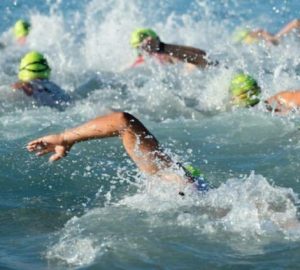How to swim faster
Swimming faster is not just for prospective Olympians, competitive triathletes or the people who always push to the front in a swimming race. Learning to swim faster is an enjoyable and fascinating journey in its own right. And having a little extra speed can come in handy in several outdoor swimming situations. For example, speed can be handy if you have to swim against or across a current. On a longer swim, being a little faster could reduce considerably the amount of time you’re in the water, and thus reduce your risk of hypothermia.
But how do you get faster?
Your swimming technique is fundamental to the speed you can swim. And, if you want to swim fast for more than just a few seconds, then building a good aerobic base through longer distance swims is essential. Other factors that determine your speed are your open water skills, your pacing judgement and your ability to cope with the conditions, such as chop, waves and the water temperature.
However, rather than thinking of improving speed as a linear process (e.g. improve technique, build your aerobic base, add speed specific training), approach it holistically. Your technique is never perfect and fixed. Wherever you are in your swimming journey, you will find things to improve. And if you don’t monitor your swimming technique (and better still ask a coach to review it periodically), flaws will creep in. You need to keep coming back to technique and refining it. But also, don’t make the mistake of waiting until you’ve got perfect technique before working on your speed, because your technique will never be flawless.
Similarly, your aerobic fitness will wax and wane with the amount and type of training you do. Even after you’ve built a good endurance base, you need to maintain it with steady paced longer distance efforts.
In open water, your all-out sprint speed is almost irrelevant. Most events last a minimum of 10 minutes and the longer ones go on for hours. What you need is sustainable speed: a pace you can maintain for the full duration of your swimming challenge.
Interval training
The time-honoured, and effective, way to do this is with interval training (see examples of training sessions below) based on your critical swim speed. Once you can swim several hundred metres without getting breathless, try adding these to your swimming, initially once per week.
In order to swim with good technique, and to maintain good technique as you get tired, it helps to have reasonable mobility, flexibility and strength, including core strength. If you don’t do this already, try adding some land-based exercises once or twice each week to address this.
Be consistent in your training. Two sessions per week, every week, will do you more good than six sessions a week for a few months and then burning out. Just keep doing it.
If you want to swim faster in open water, then make sure you practice in open water to hone your skills. Many fast swimmers slow down considerably outside because they struggle to adapt to the conditions. In particular, a lot of swimmers slow down – in some cases they almost stop – when sighting.
Sighting
Sighting is an essential open water skill. You need to look where you’re going and keep an eye out for potential hazards in the water. Done well, sighting barely interrupts your stroke. Lift your eyes (not your full head) out of the water as you initiate the catch, look, turn your head to breathe while lowering back into the water. If you don’t see what you need to see, look again on the next stroke cycle rather than pausing and lifting your head higher. Focus on keeping your momentum. If necessary, kick slightly harder to prevent your legs sinking. Get your head back into a streamlined position as quickly as you can. Practice lots.
Don’t rush it. Getting faster takes time and patience. Be consistent, be thoughtful and seek assistance.
Critical Swim Speed training
Critical Swim Speed (or CSS) sounds alarming but it’s a straightforward, science-backed approach to swimming faster and with better pacing.
CSS is defined as theoretical maximal swimming speed that could be maintained without exhaustion for a long period of time. You improve your CSS by doing structured training at that speed, which you first should identify using 400m and 200m time trials. Swim coaching company Swim Smooth has a handy calculator on their website into which you can plug your test times and reveal your CSS. Mostly, CSS is expressed in pace per 100m, as this makes it simple to use in pool training.
Once you know what your CSS is, you can design training sessions specifically to improve it.
The key to doing these sets well, and getting the most benefit from them, is to pace them evenly throughout. Do not start too fast!
How to design your own CCS-based training sets
A typical CSS main set should take you around 25 minutes to complete, of which about 85 to 90% of the time will be spent swimming and the balance resting. As a rough guide, take your CSS, add 12.5% and then round up or down to the nearest 5 seconds to give you your base time for each 100m. Then, divide 25 by your base time to find the total distance for your set.
Now, get creative. A simple way to do it would be a set of 100m swims, but you could break it into a mixture of 50m, 100m and 200m swims as you like.
This probably sounds complicated, but work through the example below and it will all make sense.
Example
CSS = 1:30 (1 minute 30 seconds per 100m)
CSS + 12.5% = 1:41.25
Round to nearest 5s for a base time of 1:40 per 100m and then work out your total target distance as follows:
· 25 / 1:40 = 15 (ie. 1500m minimum distance)
You could divide this as:
· 30 x 50m FC off 50s (target time is 45s for each 50m, with 5s rest after each)
· 15 x 100m FC off 1:40 (target time is 1:30 for each 100m, with 10s rest after each)
· 7 x 200m FC off 3:20 (target time is 3:00 for each 200m, with 20s rest after each) + 1 x 100m
Or mix it up to do 4 x 200m, 4 x 100m, 6 x 50m
Don’t forget to warm up first and cool down after with some easy swimming.
Check out the Swim Smooth CSS calculator at: www.swimsmooth.com/improve/intermediate/swim-smooth-css-calculator
Read more:
How to swim further







